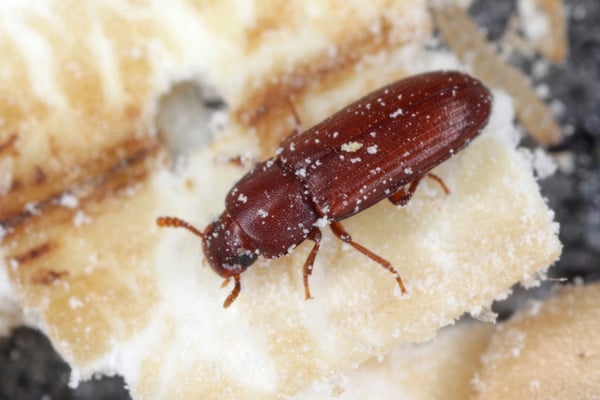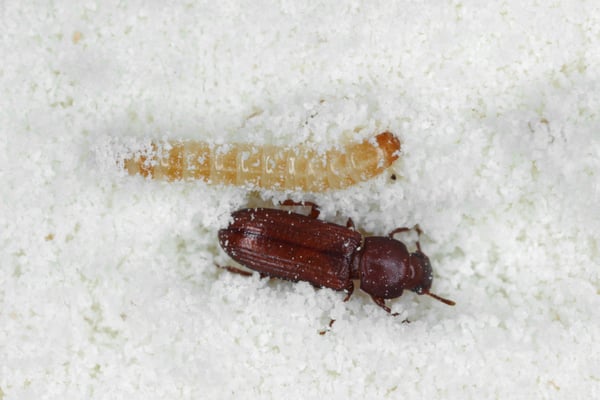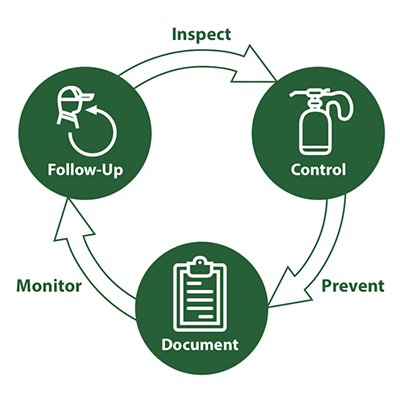Red Flour Beetles and Confused Flour Beetles
Appearance And Behavior
Red flour beetles (Tribolium castaneum) and Confused flour beetles (Tribolium confusum) are actually two different species of beetle. These two species simply look and behave so similarly, that they’re often mistaken for each other. The name “confused” flour beetle actually references the fact that scientists confused this beetle for its red relative until quite recently!
Both of these stored product pests live all over the world, and they’re both found in the US. Whichever you have, they’re trouble in the same way, which is why we’ve grouped them together here. Plus, we find it kind of appropriate.
Both red flour beetles and confused flour beetles measure about 1/8 inches long. Their bodies are dark red or brown. It’s difficult to tell them apart at all, but if you really want to, we recommend examining the antennae. Red flour beetle antennae terminate in an abrupt, 3-segmented club. Confused flour beetle antennae, meanwhile, gradually widen from the head outward. If you see one of the beetles flying, then it is a red flour beetle. Red flour beetles will fly short distances, but confused flour beetles never fly.
Red flour and confused flower larvae also look extremely similar to one another. They’re both 1/8 to 1/4 inches long, yellowish white, and wiry in appearance. You’ll find these larvae nestled in flour or other grain products.
Red flour and confused flour beetles tend to live much longer than other, similar stored product infesting pests. Unfortunately, they’re also prolific breeders, and actively reproduce for most of their life cycle. Female beetles live for 2 to 3 years and can lay 2 to 3 eggs per day. In ideal conditions, beetles could successfully generate 4 or 5 generations of offspring in a single year.

Every day, female flour beetles deposit clear, white, sticky eggs onto or near ideal food materials. A single female can eventually produce 300 to 500 of these eggs in her lifetime. The eggs hatch into brownish-white larvae within 5 to 12 days. As larvae, the beetles must undergo 5 to 18 instars while growing before they can successfully pupate. When they’ve eaten enough, larvae quickly pupate, emerge as adults, and begin reproducing immediately. Depending on environmental temperature, this life cycle could take anywhere between 7 weeks to 3 months or longer.
Red flour and confused flour beetles are incapable of feeding on whole kernels or undamaged grains. Instead, they feed on damaged grains, soft grain products, or other vulnerable dry goods. Inside, they often infest flour (obviously), bread, nuts, dried fruit, spice, chocolate, herbs, or dried insect remains. They’re mainly attracted to flour that’s moist or stored in highly-humid environments.
They do not injure humans, but flour beetles may leave behind a disagreeable odor in the products they infest. Red flour beetle adults can fly short distances and tend to fly toward light sources. Confused flour beetles often crawl towards light sources.
Red Flour Beetle and Confused Flour Beetle Prevention

The first step toward stopping red flour and confused flour beetle infestations is locating and removing food sources. Store flour, cereal, and other vulnerable food products in airtight, thick plastic containers. Treating infested items with heat (140°F for 30 minutes) or cold (0°F or colder for 72 hours) will destroy eggs, larvae, and adults living in them. These treatments may not destroy pupae, however.
After removing the current infestation, you should thoroughly clean out the infestation site. Throw out infested food, clean up crumbs and debris, and vacuum thoroughly. Be sure to throw out the vacuum bag when you’re finished. Make a regular cleaning schedule for vulnerable infestation areas and stick to it. Sanitation is the single most important way to keep pests like these beetles away.
Red Flour Beetle and Confused Flour Beetle Control Process
Plunkett’s pest pros will start treating your red flour or confused flour beetle infestation by finding all infestation sites. We’ll locate where the beetles feed, reproduce, lay eggs, and pupate. After we’ve wiped out existing infestations, we’ll figure out how the beetles accessed these sites in the first place. Then, we’ll either make small repairs ourselves or recommend how you can fix up possible access points permanently. In some cases, we may apply insecticide dust or spray to cracks, crevices, structural voids, and other vulnerable areas. These insecticide formulations will help repel future infestations after we’ve gone.
We follow specific plans for dealing with beetle infestations in large commercial settings, such as food processing plants, mills, or warehouses. Here, we’ll strategically place insect pheromone traps and insect light traps. These tools help use monitor pest activity so that we can discover and remove the internal breeding sources. If necessary, we can also fumigate facilities using ULV or thermal fogging equipment. We may use a synergized pyrethrum insecticide to eliminate large pest populations.
Whether you have red flour beetles or confused flour beetles, just contact Plunkett’s today. We’ll identify your beetles, remove them, and help make sure they can’t bother you again.

Beetle Control With Plunkett's
At Plunkett’s, our goal is to help you quickly, conveniently, and in the most cost-effective way. We make every effort to be with you asap, usually within a day or two.
Learn More
There are a good number of stored product pests that are particularly likely to make pests of themselves around your home. Some of the most common examples of stored product pests Plunkett’s encounters frequently include:






